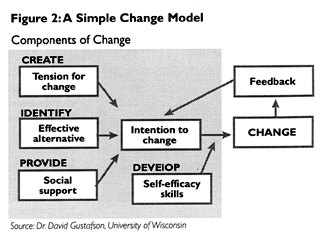
Theories of Adult Learning
The bottom half of figure 1
describes some of the key points from the modern research into how adults learn. (Knowles,
1990) Notice that the themes of information flow, mental models, emergence, and context
are woven throughout these findings. Not surprisingly, adults learn best when the learning
methods are consistent with the notions of complex adaptive systems.
When it comes to adult learning
in organizations, there is plenty of evidence for discarding the machine and military
metaphors. Perhaps a better metaphor for learning is that of sowing seeds. Successful,
growing, living learning about complexity depends on the quality of the seed (the
information itself), the skill of the farmer (the one guiding the learning process), the
condition of the soil (the openness of the learners), and a little bit of luck in the
weather (the events in the organizational context). Importantly, most farmers will admit
that the seed, soil, and weather have more to do with success than the farmer.
The research on adult learning
also suggests that retention of learning is a key challenge. Adults remember only about
10% of what the read and 50% of what they see and hear. But they retain around 70% of what
they say themselves and about 90% of what they do. Furthermore, regardless of how the
learning originally occurred, the research also indicates that retention can be further
enhanced by repetition, connecting with existing knowledge, emotional intensity for the
learner, and active involvement of the learner in the learning process. In other words,
effective learning is action- and reflection-oriented.
The modern concept of reflective
learning can be traced to philosopher John Dewey, and was further developed by several
great change experts and psychologists such as Jean Piaget, Donald Schon, and W. Edwards
Deming. Reflection is the "Study" phase of the Shewhart-Deming cycle of
Plan-Do-Study-Act (PDSA). David Kolb places it explicitly in his learning cycle of
Deciding-Doing-Reflecting-Connecting (leading to another cycle of Deciding...).
In application to learning about
CAS, we can make the following observations about learning to learn more effectively (for
more about the skill of reflection, see the Aides section of this Resource Kit):
- We need to make time and space for reflection. It is not easy to do amid the rush and pressure of daily work life.
- Remember Stacey's Diagram: don't agree too much or too soon.
- Different people will take away different reflective learnings from any experience; this is natural and healthy.
- The skill of reflection takes time to master -
and you never really get there because there is always another interpretation that one
could put on any collection of events. Be patient with yourself and others as reflective
learning progresses.
The goal of our learning about
CAS (indeed, as Kirkpatrick (1975) points out, the goal of all learning) must be about
changing behaviors in our organizational context. Therefore, theories of change management
are also relevant to our thinking about how to set up environments that increase the
likelihood for learning.
Organizational change theory is,
of course, a vast field of study that is well beyond our scope here. But figure 2 provides
a simple model that summarizes the key points (Source: Dr. David Gustafson, University of
Wisconsin, Madison). Change is more likely to occur when: there is tension for change,
when the new way has some clear advantage over the old, when change is also embraced by
others, and when people have the necessary skills to do things differently.
This suggests that learning
activities about CAS should include some reflection on the gaps between our traditional mental models and the reality we actually experience
in the world (tension for change). Learning activities about CAS might also profitably
include some "sense-making" in the form of a re-interpretation of events through
a complexity lens (effective alternative). Learning activities about CAS should be joint
and shared (social support). And learning activities about CAS should leave participants
with new competencies (skill building).
on the gaps between our traditional mental models and the reality we actually experience
in the world (tension for change). Learning activities about CAS might also profitably
include some "sense-making" in the form of a re-interpretation of events through
a complexity lens (effective alternative). Learning activities about CAS should be joint
and shared (social support). And learning activities about CAS should leave participants
with new competencies (skill building).
Figure 3 provides a final summary of key principles from the field of adult learning. Re-read these principles often as you work to spread knowledge about CAS among those with whom you interact. It is easy to fall back into old habits and mental models about how learning should happen; the principles in figure 3 are, unfortunately, easy to forget.
Figure 3: Summary of Key
Adult Learning Principles
|
Next | Previous | Return to Contents List
Copyright © 2001, Paul E.
Plsek & Associates,
www.directedcreativity.com
Permission to copy for educational purposes only.
All other rights reserved.